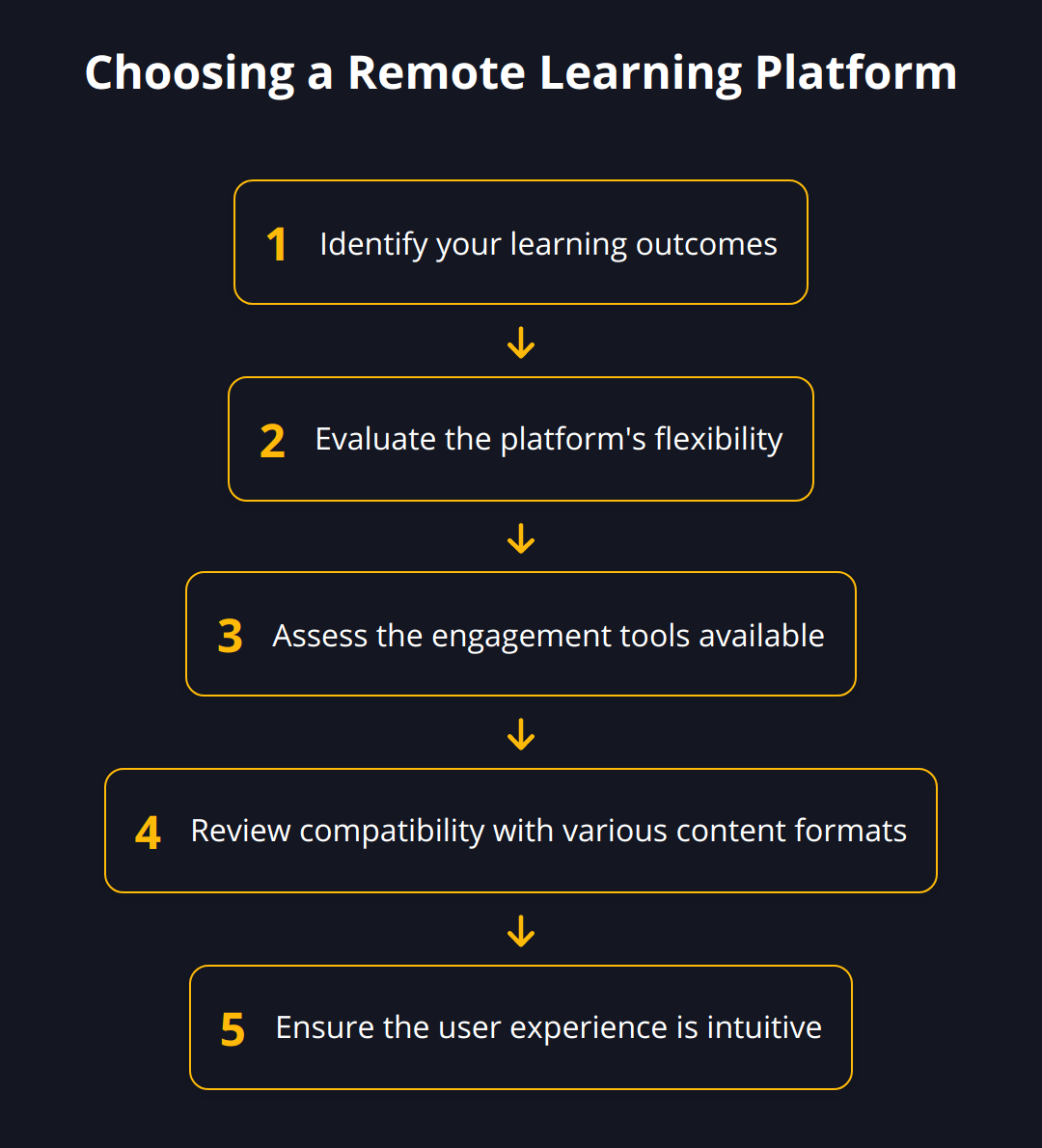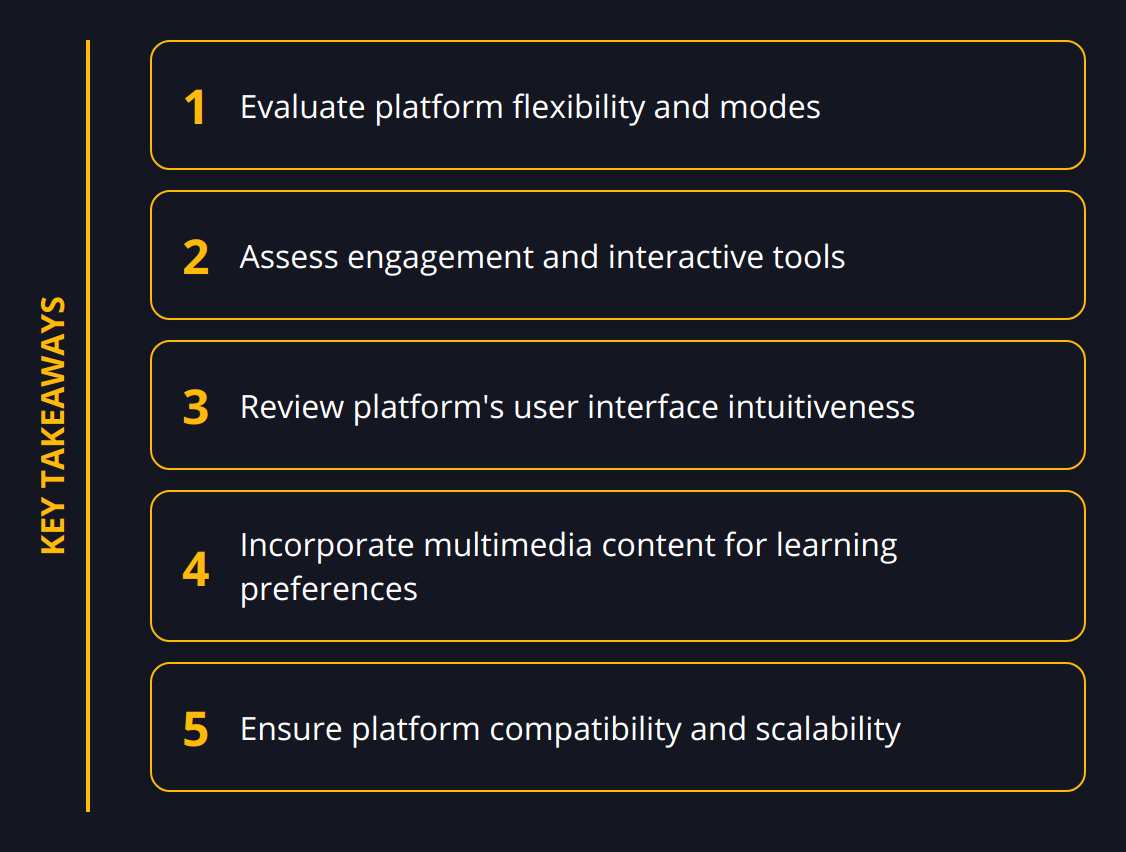Remote learning has fundamentally changed the educational landscape, bridging the physical gaps between learners and institutions. At Newroom Connect, we understand the vitality of having a comprehensive guide to navigate through the myriad of remote learning platforms available. Here, you’ll uncover the essential elements that define successful online education experiences and how to select a platform that aligns with your specific learning goals. We also highlight strategies to enhance engagement and track progress to optimize the remote learning experience.
Selecting Remote Learning Platforms
Remote learning platforms are more than just digital workspaces; they are the engine rooms of online education. We’re witnessing an era in which virtually every learning requirement can be met with the right remote learning solution. However, selecting the best platform requires a nuanced understanding of your needs and the capabilities of various platforms.
Firstly, remote learning exists to tear down the barriers of traditional education, allowing learners to access information anytime, from anywhere. It’s not just about convenience; it’s about inclusivity and adaptability. Balancing synchronous (real-time interaction) and asynchronous (coursework completed at one’s own pace) learning opportunities, platforms support diverse learning styles and schedules.
The types of environments that these platforms create can widely vary. For instance, platforms offering video tutorials and quizzes favor self-paced, independent study, while those with virtual classrooms emphasize real-time dialogue and interaction. A mix of both environments tends to yield the most comprehensive experience, catering to different learner’s needs.
Technology, the backbone of remote education, constantly evolves to create intuitive and collaborative learning experiences. We’re talking about Learning Management Systems (LMS) such as Moodle or Blackboard, which track progress and deliver content, or webinar tools like Zoom or Google Meet, which connect learners directly with instructors. Nevertheless, a platform’s greatness isn’t solely determined by its features but by how well those features align with your learning outcomes.

To choose wisely, consider the following:
-
Evaluate flexibility: Can the platform shift between synchronous and asynchronous modes seamlessly?
-
Assess engagement tools: Does it have interactive elements, such as forums or chat, which encourage collaboration?
-
Review content compatibility: Can you integrate various content formats, such as video, text, and interactive simulations?
-
Understand user experience: Is the interface user-friendly? Do students find the navigation intuitive?

Remember, platforms like Coursera and Skillshare may cater well to individual learners seeking a range of courses, but may not necessarily fit corporate training needs. For a more tailored approach aimed at integrating with a company’s workflows and providing analytics, a platform like EdApp, mentioned earlier for its customizability and reporting capabilities, might be more appropriate.
To wrap up, choosing a remote learning platform is a strategic decision that impacts learner engagement and educational outcomes. Let the platform be your partner in delivering education that transcends geographical limitations. Select with intention, and you’ll harness the full potential of remote learning.
In the forthcoming chapter, we’ll explore strategies to effectively utilize these platforms to foster active learning and retention.
Maximizing Platform Potential
A successful remote learning platform isn’t just about bridging distances; it’s about creating an intuitive and engaging environment that rivals the physical classroom. The caliber of a platform is judged by its ability to provide a seamless, user-friendly experience across various devices and cater to diverse learning styles through multimedia content and interactive tools. A standout platform also empowers learners with customizable paths and offers real-time feedback to reinforce learning.

A robust remote learning platform should prize simplicity and usability. If students are battling to navigate your system rather than their coursework, it’s a problem. An intuitive design ensures that learners, regardless of tech savviness, can focus on learning. Platforms need to be accessible across multiple devices, making learning flexible and within reach, whether on a desktop at home or a smartphone on the go.
Moreover, incorporating a blend of multimedia content is non-negotiable for capturing learner interest and accommodating different learning modes. Videos, podcasts, and interactive simulations engage learners far more than text-heavy materials. They provide visual, auditory, and kinesthetic learning opportunities making concepts stick.
Yet, what sets a platform apart isn’t just variety, but the ability to customize this content into coherent learning paths. Learners should be able to progress through material that adapts to their pace and preferences. The best platforms empower learners to take charge of their educational journey.
Receiving real-time feedback is another critical feature, as it allows learners to identify areas needing improvement promptly. The immediacy of such feedback mirrors the responsiveness of a physical classroom and serves to bolster learner confidence, ensuring they are on the right track.

Here are some practical tips for ensuring platform potential is maximized:
-
Conduct user testing to identify navigation issues
-
Opt for platforms offering cross-device compatibility
-
Incorporate diverse content formats to cater to different learning preferences
-
Customize learning paths to match learner goals
-
Implement tools for immediate learner feedback
The rise in eLearning has cultivated an expectation for well-rounded, dynamic online education environments. With the increased demand for remote learning platforms, one thing stands clear: those who prioritize a blend of user-friendly design, diverse content, customization, and instantaneous feedback will lead the pack. To further explore ways of boosting engagement within these platforms, check out our insights on learner engagement strategies.
In the next chapter, one will understand how these pivotal features converge to foster active learning and lay the groundwork for not just knowledge retention, but knowledge application.
Aligning Platform Choices with Goals
Selecting the right remote learning platform is akin to choosing a partner in your educational journey – picking one that truly understands and caters to your objectives is essential. Let’s steer through some concrete steps to align platform choices with your specific learning goals and needs.
Assessing Learning Objectives and Needs

Pinpointing what you want to achieve with online education is the starting block. Your objectives guide the platform’s role in your learning or training programs. Whether it’s skill development, certification, employee onboarding, or continuous education, the platform’s ability to meet these objectives should be paramount in your selection process. For instance, if immediate skill application in the workplace is what you’re after, platforms that offer practical simulations and real-time feedback will serve you better than those with a focus on academic courses.
Scrutinizing Pricing, Scalability, and Support
Budget will invariably influence your choice. But don’t just opt for the cheapest option; instead, look for value. A seemingly inexpensive platform may cost you more in the long run if it can’t scale with your needs or lacks essential support. Consider the overall cost, including any hidden fees for additional features or users. Also, evaluate the provider’s customer service. Excellent ongoing support can make a massive difference in helping you overcome any technical challenges, ensuring a smooth learning experience.
Compatibility Checks
It’s critical that any potential platform plays well with existing systems. Ensure that your choice can integrate with the software your organization already uses, such as CRM or HR systems. Ignoring compatibility can lead to siloed systems and reduced efficiency. Additionally, explore API options and functionality, as these integrations can streamline processes and data flow, making both the administrator’s and learner’s lives easier.
Here are direct actions to take in the selection process:
-
Match Goals with Features: List your objectives and match them with platform features.
-
Analyze Costs: Look beyond the sticker price to understand the total cost of ownership.
-
Test Interoperability: Use trials or demos to test how well the platform integrates with your current tools.
-
Assess Support: Review the level of support offered and look for reviews or testimonials to gauge its effectiveness.
Taking these steps earnestly will lead you to a platform that not only fits your budget and integrates into your infrastructure but also elevates your learning outcomes. We understand that adapting to the dynamics of online education requires a careful blending of technology and pedagogy. For further insights, you might find our comprehensive guide on e-learning platform trends particularly helpful to stay ahead in the evolving landscape of remote learning.
Next, we’ll explore how to leverage these platforms to the fullest, ensuring active engagement and the application of newfound knowledge.
Harnessing Remote Learning Tools
In today’s digital learning sphere, the sophisticated features of remote learning platforms are crucial elements in the arsenal of effective education. But how do we ensure that we’re maximizing these tools to their fullest potential?
Leveraging Collaboration for Deeper Learning
Social learning isn’t just a buzzword—it’s the heartbeat of knowledge retention and community building. By integrating features that support collaboration, discussions, and peer-to-peer interaction, you create a vibrant educational ecosystem. Platforms like Flip are seen enhancing engagement by making space for secure group sharing and dialogue.
To foster a socially-rich learning environment, actively promote discussion boards or peer review systems that involve learners in the material and one another. When students feel like part of a community, they’re more likely to engage deeply and contribute more significantly. Tools that allow group projects or shared assignments can significantly heighten the collaborative experience.
Unlocking Insights with Analytics
Data is king in the modern educational landscape. By utilizing analytics and reporting features, you can gain tangible insights into learner progress and course effectiveness. Platforms offering comprehensive reporting help identify learning gaps for both individuals and teams.
With real-time data, educators can tailor lessons to address those gaps and learners can track their own progress, staying motivated and informed about their growth. Implementing a feedback loop based on such data is powerful. It turns assessment into a tool for ongoing improvement rather than merely a bureaucratic requirement.
Boosting Engagement with Gamification
The genius of gamification lies in its ability to invigorate the learning experience, making it more enjoyable and, as a result, more impactful. EdApp, as an example, has successfully integrated gamification, incentivizing learners with points, badges, or other rewards to motivate continued progression through course materials.
For maximal effect, gamification should be thoughtfully integrated, aligning with learning outcomes rather than being a mere add-on. It’s about transforming the educational journey into something captivating, which, in turn, drives engagement and enhances the retention of knowledge and skills.
To wrap up, don’t let the plethora of tools intimidate you. Here’s a quick guide to get the most out of these powerful features:
-
Prioritize platforms that support dynamic group interactions and social learning.
-
Analyze the depth and functionality of analytics and reporting—ensure the ability to track individual and group progress.
-
Innovate with gamification, but keep it aligned with your educational goals.
In summary, when we thoughtfully select and exploit the myriad features of remote learning platforms, we set the stage for more engaging, effective, and personalized education. For insights on analytics and their role in shaping educational strategies, our guide on analyzing attendee feedback may offer further enlightenment.
Stay with us as we navigate further into the steps one should take to implement and maintain these platforms effectively, ensuring they are a boon to your digital learning initiatives rather than just a background tool.
Wrapping Up
As we reflect on the landscape of remote learning platforms, we recognize that the choice of platform can significantly influence the success of online educational endeavors. At Newroom Connect, we advocate for informed decision-making that accounts for the specific dynamics of remote learning and matches the platform’s strength to your unique learning objectives.

Embrace Platform Potential
The right platform can be a game-changer in the virtual learning context. It’s essential not to view platforms as mere repositories of content but as gateways to immersive learning experiences. The ideal platform is not static; it grows with your needs, scales with your ambitions, and responds to the evolving demands of education. We underscore the importance of adaptability, catering not only to current educational needs but also to unforeseen future requirements.
Cultivate a Responsive Learning Environment
The acceleration of remote learning adoption demands that platforms do more than function effectively; they must create an environment that encourages active participation and fosters a community. Asynchronous and synchronous features, social collaboration tools, and real-time feedback are vital in nurturing this environment. We encourage learners and educators alike to not only use a platform’s features but to engage with them deeply, shaping the learning experience to be as dynamic and responsive as the physical classroom.
Anticipate and Integrate Technological Advances
The horizon of remote learning is always expanding, with continual advances in technology offering new and improved ways to connect and educate. Forward-thinking platforms constantly evolve, infusing the latest tech discoveries to deliver a richer learning experience. Anticipation of these advancements and readiness to integrate them into the learning process are key to maintaining a competitive edge in the realm of online education.
We at Newroom Connect are committed to providing solutions that not only meet the current standard but also pave the way for future innovations in digital learning. With the ability to create virtual trade fairs, showrooms, or e-learning platforms, we strive to be at the forefront of remote learning, ensuring that our clients have access to cutting-edge tools for delivering impactful and lasting education experiences.
In closing, the pursuit of the perfect remote learning platform is a journey that entails ongoing adaptation and innovation. A deliberate choice, alignment with educational goals, and readiness to embrace emerging technologies define the most successful platforms. As you continue to navigate the wide array of options available, we at Newroom Connect believe that informed, forward-thinking choices will lead to richer learning environments and more effective education delivery for all involved.


